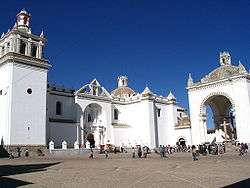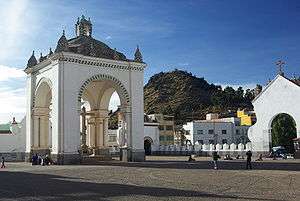Basilica of Our Lady of Copacabana
The Basilica of Our Lady of Copacabana is a 16th-century Spanish colonial shrine that houses the image of the Virgen de Copacabana.[1] It is located in the town of Copacabana, Bolivia on the shores of Lake Titicaca near the Altiplano region. Our Lady of Copacabana is the patron saint of Bolivia.
| Basilica of Our Lady of Copacabana | |
|---|---|
 | |
| Religion | |
| Affiliation | Catholic Church |
| District | Diocese of El Alto |
| Rite | Roman Rite |
| Location | |
| Location | Copacabana, Bolivia |
| Architecture | |
| Architect(s) | Francisco Jiménez de Siguenza |
| Style | Renaissance |
| Groundbreaking | 1669 |
| Completed | 1679 |
The current building was built between 1669-1679[2] by the Spaniard architect Francisco Jiménez de Siguenza replacing a small former church. It was originally administered by the Augustinians.[2]
Constructed at the foot of a small steep hill, sacred to the Inca and known as the Temple of Sun, it remains as one of the two principal sacred places of importance to the indigenous peoples and Catholics alike. The other is the Virgin of Urkupiña near Cochabamba, Bolivia.

Calvario
_1877_George_Squier.jpg)
The hilltop overlooking Lake Titicaca was rededicated as a "calvario" or replica of Calvary and is topped by the Stations of the Seven Sorrows of Mary and an altar with a depiction of the crucifixion of Jesus. It is a major centre of worship throughout the region during Holy Week, especially on Good Friday and Easter Sunday.
April 2013 Robbery
In the early hours of Monday, 22 April 2013, the Basilica of Our Lady of Copacabana was robbed and the image of the Virgen de Copacabana was stripped of her gold and silver accessories.[3] Initial reports indicate that twenty-eight items, including the sculpture of the baby Jesus, were removed from the Virgen de Copacabana by thieves who entered the building using a ladder stolen from a nearby telecommunications station.[4]
References
- http://www.sacred-destinations.com/bolivia/copacabana-basilica-virgen-candelaria
- Pepe Barrascout (5 August 2015). "Nuestra Señora de Copacabana – Bolivia". Cathedral of Escuintla website (in Spanish).
- Yates, Donna. "The Virgin of Copacabana has been looted". anonymousswisscollector.com. Retrieved 2013-04-30.
- Linarez, Iblin. "Los tesoros de la Virgen carecen de seguro antirrobo". la-razon.com. Retrieved 2013-04-30.
| Wikimedia Commons has media related to Copacabana Basilica. |